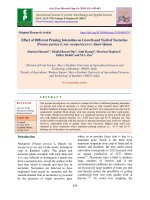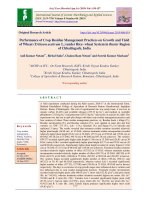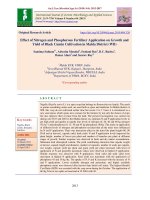modelling growth and yield of dipterocarp forests in central highlands of vietnam
Bạn đang xem bản rút gọn của tài liệu. Xem và tải ngay bản đầy đủ của tài liệu tại đây (2.98 MB, 181 trang )
TECHNISCHE UNIVERSITÄT MÜNCHEN
Lehrstuhl für Waldwachstumskunde
Modelling Growth and Yield
of Dipterocarp Forests
in Central Highlands of Vietnam
Thanh Tan Nguyen
Vollständiger Abdruck der von der Fakultät Wissenschaftszentrum Weihenstephan
für Ernährung, Landnutzung und Umwelt der Technischen Universität München zur
Erlangung des akademischen Grades eines Doktors der Naturwissenschaften
genehmigten Dissertation.
Vorsitzender(r): Univ Prof. Dr. Reinhard Mosandl
Prüfer der Dissertation:
1. Univ Prof. Dr. Hans Pretzsch
2. Univ Prof. Dr. Thomas Knoke
Die Dissertation wurde am …………………………… bei der Technischen
Universität München eingereicht und durch die Fakultät Wissenschaftszentrum
Weihenstephan für Ernährung, Landnutzung und Umwelt am
…………………………. angenommen.
i
Preface and Acknowledgements
This study was carried out under the supervision of Prof. Dr. Hans Pretzsch, Chair
for Forest Growth and Yield Science, Technische Univesität München. His excellent
guidance, advice and encouragement are gratefully acknowledged. I have learnt a lot from
him, academically and personally.
I wish to express my sincere gratitude to Dr. Peter Biber, my supervisor, who has
been full of continuous support and encouragement through out my research studies, not
only guidance in academic but also the consideration for my stay in Germany.
I would also like to use this opportunity to express my thanks to numerous people in
the Chair for Forest Growth and Yield Science, Technische Universität München, including
Dr. Stefan Seifert, who has helped me a lot in several aspects, especially computer
techniques, Prof. Dr. Thomas Seifert, Dr. Hans-Joachim Klemmt, Dr. Tobias Mette, Marga
Schmid, Enno Uhl, Ralf Moshammer, Leonhard Steinacker, and all the colleagues in the
Chair for their never ending help and encouragement.
I am also indebted to many people at Tay Nguyen University, where I have worked,
for their useful comments, valuable advice and encouragement especially Assoc. Prof. Dr.
Bao Huy, Department of forest resources and environment management, Assoc. Prof. Dr.
Nguyen Xuan Thao, the rector of the University, Dr. Nguyen Tan Vui, the vice rector of the
University, Dr. Nguyen Van Thuy, the dean of the faculty of agriculture and forestry, and
all my colleagues at the faculty.
I wish to thank Mr. Nguyen Dinh Son, Branch of Forest Inventory and Planning
Institute of Vietnam in Central Highlands for generously providing valuable data from
permanent plots of Dipterocarp forests.
Without the assistance of students at Tay Nguyen University, various stages of my
field work would have been very difficult. I earnestly acknowledge the assistance of a
student team including Tuan, Quynh and Huy.
I gratefully acknowledge 322 Project, Ministry of Education and Training, Vietnam
Government for supporting my research studies with scholarship and DAAD (Deutscher
Akademischer Austausch Dienst) for providing additional financial assistance during my
study and stay in Germany.
ii
Last but not least, I would like to acknowledge the patience, consideration and
encouragement from my loving wife, Dang Thi Thuy Thao and my daughter, Nguyen Thuy
Dzung who not only managed my absence but also provided me with constant passion and
motivation for my work.
Freising, September 2009
Thanh Tan Nguyen
iii
Abstract
Dipterocarp forests in Vietnam are distinct ecosystems with specific characteristics
which are different from other forest types such as evergreen forests, semi-deciduous
forests and conifer forests. According to inventory results of the Forest Inventory and
Planning Institute of Vietnam in 2005, the area of the Dipterocarp forests is approximately
680.000 ha, accounting about 5.4% the total forest area of the country and concentrates
mainly in the Central Highlands of Vietnam.
The main objective of this study is to develop a size class model based on systems
of differential equations for supporting sustainable management of the Dipterocarp forests
in Vietnam. Two data sets collected in the Dipterocarp forest in YokDon National Park
were used in this study to construct the growth model and calculate the main stand level
characteristics. They include plot group A consisting of twelve one-hectare permanent plots
with two measurements of a 5-year growth interval, and plot group B of 21 one fourth
hectare plots with a single measurement. For calibrating the growth model, only data set of
group A plots was used. In addition to be used to calculate the main stand level parameters,
the group B plots will supply reliable data sources to recalibrate the model in the future.
The study area was classified into three site quality levels based on mean height of the 20
largest trees in each plot. The measurements on these permanent plots recorded a total of
4,975 trees belonging to 64 species with diameter at breast height (dbh) from 6 cm and
above. Based on biological characteristics, trees on these plots were grouped into three
species groups: Dipterocarp species, evergreen tall species, and small-sized, lower species.
The diameter distribution of the average stands follows the form of negative exponential
distribution for all three species groups in accordance with the distribution rule of natural
uneven-aged forests. The number of trees per hectare has a tendency to decrease when
diameter increases. Stand basal area ranges from 10.15 to 26.9 m
2
ha
-1
and the range of
basal area increment is between 0.27 and 0.48 m
2
ha
-1
yr
-1
. Standing volume ranges from
53.8 to 208.8 m
3
ha
-1
and the range of standing volume increment between 1.5 and 3.86
m
3
ha
-1
yr
-1
. The number of tree per hectare ranges from 223 to 1.156 trees ha
-1
.
The four major components of the growth model are diameter increment, mortality,
recruitment and harvesting. The first three models were developed separately for each
species group and site quality level. Multiple linear regression, non-linear regression and
logistic regression were used to estimate the parameters of diameter increment, recruitment
and mortality functions. Significant stand level variables included stand basal area, basal
area in larger trees, tree number, site quality, and significant individual-tree level variables
were diameter, diameter squared and reciprocal of diameter. Selecting the model equations
iv
was based on the following criteria: suitability of biological interpretation and goodness-of-
fit statistics. The results indicated that diameter growth level of three species groups on
different site quality levels was significantly different with the exception of species group 3
on good and medium site quality. Trees grow more quickly on good sites than on poor
ones. However, the effect of site quality on mortality rate was not obvious in this study.
These major components were then embedded to the final growth model which is a size
class management-oriented model. The model was implemented in the framework of the
modelling software Vensim DSS 5.7a. It consists of 76 one-cm diameter classes ranging
from 6 to 81cm dbh for three species groups, the last class gathering all trees with diameter
above 80.5cm. Time interval for each simulation step of the model was set one year and
diameter class width was one cm.
A thorough evaluation of the growth model showed that the models were fitted very
well with the empirical data. Simulation results with the models showed that the difference
between observed and predicted values of basal areas and tree number distribution by
diameter class for a growth period of five years was small. The long-term performances of
the simulation proved plausible states of the stand evolution which is consistent with
general knowledge of stand growth over long time. This indicates that the model can be
applied in practice.
The example applications of the growth model in determining appropriate
silvicultural regimes based on the method of scenario analysis. Given the initial condition
of the stand, the model estimated the state of the stand after given years with the alternative
assumed prescriptions. The simulation results indicated that, with a selection harvesting
cycle of 10 years, different initial stand distributions will produce different sustainable
yields. The q-factor method was applied to determine the target diameter distributions that
produce maximum sustainable yields on three site qualities. The maximum diameters for
each species group were selected based on management purpose and diameter growth level
as follows: for species group 1 and 2, maximum diameters are 70, 60 and 50 cm for good,
medium and poor site quality, respectively. For species group 3, maximum diameter is 35
cm for all site qualities. From the simulation results of the model, the following target
distributions have been defined: on good site quality with following parameters: basal area
equal to 20 m
2
ha
-1
, q-quotient (slope of the stem number-diameter distribution of 5 cm
classes) equal to 1.4, with the sustainable yield of 3.91 m
3
ha
-1
yr
-1
. For medium site quality:
basal area equal to 18 m
2
ha
-1
, q-quotient equal to 1.5, sustainable yield of 3.22 m
3
ha
-1
yr
-1
.
And on poor site quality: basal area equal to 16 m
2
ha
-1
, q-quotient equal to 1.6, sustainable
yield of 2.75 m
3
ha
-1
yr
-1
. In addition, the model was also used to estimate the return time
that regulates a given stand towards the target distribution stand for the twelve plots of
group A and to assess effect of wildfires on long-term yields of the Dipterocarp forests.
v
The example applications presented in this study provide valuable information to
the forest managers for supporting decision making in sustainable management of
Dipterocarp forests. Other applications of the model need to be further explored in specific
contexts of the production practice.
Although there were several studies on growth and yield of natural uneven-aged
forests in Vietnam before, those studies modeled only important species in the forests and
produced yield tables dependent on the age of trees that provide less information for forest
management. In comparison to those studies, this growth model was constructed
incorporating competition effects as well as mortality and recruitment so that it has the
advantage of being able to estimate the growth of forests dynamically and independent on
the tree age for long time spans with reliable results.
However, due to the comparably small amount of data available in this study, all
data was used to calibrate the model, there was no data set aside for validating the model.
So, it is necessary to obtain more data from permanent plots and when it is available the
model should be recalibrated in order to expand the geographic research area and achieve
more accurate results. Although the growth model in this study was developed for
Dipterocarp forests that are uneven-aged, multi-species deciduous forests, the approach can
be applied to develop models for other forest types such as evergreen, semi-evergreen
forests or plantation forests.
vi
Zusammenfassung
[german] Das Ziel dieser Arbeit ist die Entwicklung eines differentialgleichungsbasierten
Durchmesserklassen-Wachstumsmodells für nachhaltige Bewirtschaftung von
Dipterocarpaceenwäldern in Vietnam. Die Daten wurden im YokDon Nationalpark
erhoben. Das Programm besteht aus vier Modulen zur Abschätzung des
Durchmesserzuwachses, der Mortalität, der Verjüngung und einem Durchforstungsmodell.
Als Simulationssoftware wurde Vensim DSS 5.7a verwendet. Das Modell wurde eingesetzt,
um über Szenarioanalysen geeignete Behandlungsstrategien zu finden.
vii
Table of contents
Preface and Acknowledgements i
Abstract iii
Zusammenfassung vi
Table of contents vii
List of figures xi
List of tables xiii
Chapter 1 Introduction 01
1.1 General Introduction 01
1.2 Research Questions and Objective of the Study 05
1.3 Outline of the Dissertation 06
Chapter 2 Literature Review 08
2.1 Studies About Forest Structure and Growth in Vietnam in General 08
2.1.1 Studies about Forest Growth and Yield 08
2.1.2 Studies about Diameter Distribution Rules 10
2.2 Studies about Dipterocarp Forests 11
2.2.1 Studies about the Dipterocarp Forests in the World 11
2.2.2 Studies about the Dipterocarp Forests in Vietnam 12
2.3 Historical Development and Classification of Forest Growth and Yield
Models 18
2.3.1 Stand Growth Models Based on Mean Stand Variables 18
2.3.2 Stem Number Frequency Models 19
2.3.3 Single-Tree Orientated Management Models 21
2.3.4 Gap and Hybrid Models 22
2.3.5 Matter Balance Models 22
2.3.6 Landscape Models 23
2.3.7 Selection of the Model Approach to be Used in This Study 24
viii
Chapter 3 Study Area and Establishment of Research Plots 26
3.1 General Information about the Study Area 26
3.1.1 Geographic Position and Boundary of the YokDon National Park 26
3.1.2 Forest types in the Park 27
3.1.3 Topography and Hydrography 28
3.1.4 Climate 30
3.1.5 Flore and Fauna Resources 31
3.1.6 Social Economic Conditions 32
3.2 Establishment of Research Plots as an Empirical Data Base for
Modelling Growth and Yield in Dipterocarp Forests 33
Chapter 4 Data and Description of Stand Characteristics 38
4.1 Ecological Classification of the Research Plots by Species Composition 38
4.2 Establishment of Stand Height Curves and Site Quality Classification 43
4.2.1 Selecting Height Curve Functions 43
4.2.2 Categorizing Species Groups 44
4.2.3 The Results of Height Curve Fitting 46
4.2.4 Site Quality Classification 47
4.3 Data sets 48
4.3.1 Data for Calculating Stand Characteristics 48
4.3.2 Data Used to Calibrate the Growth Model 49
4.4 Stand Variables 53
4.4.1 The Method of Calculating Stand Variables 53
4.4.2 Calculation of Stand Variables 53
4.4.3 Relationships between Stand Variables 57
Chapter 5 Model Conception and Parameterization 60
5.1 Model Conception 60
5.1.1 The Concept of System Dynamics Diagrams 60
5.1.2 Model Structure and Implementation 62
ix
5.2 Development of the Major Components of the Growth Model 71
5.2.1 Diameter Increment Model 71
5.2.2 Mortality Model 74
5.2.3 Recruitment Model 76
5.3 Results of Model Parameterization 77
5.3.1 Diameter Increment Model 77
5.3.2 Mortality Model 81
5.3.3 Recruitment Model 84
Chapter 6 Model Evaluation 88
6.1 Evaluation of the Model Approach 89
6.2 Validation of the Growth Model 90
6.2.1 Short-Term Prediction of a 5-Year Period 91
6.2.2 Long-Term Validation of Steady States 94
6.3 Evaluation of the Growth Simulator 99
Chapter 7 Applications of the Growth Model DIGROW 101
7.1 Estimation of the Growth and Yield of Forest Stands and Determination
of the Target Diameter Distributions 102
7.2 Estimation of Time to Regulate a Given Stand to Target Stand 110
7.3 Evaluation of Effects of Wildfires on Long-Term Sustainable Forest Yield 114
Chapter 8 Discussion 118
8.1 Growth Model Approach and Parameterization 118
8.2 Simulation Results of the Growth Model 121
8.3 Effects of Wildfire 123
Chapter 9 Conclusion and Perspective 124
9.1 General Conclusion 124
9.1.1 The growth Model Approach and Development 124
9.1.2 Model Applications 125
9.1.3 Data Assessment 126
9.2 Perspective of the Study 127
x
9.2.1 Recalibration of the Growth Model and Extention of its Applications 127
9.2.2 Development of Growth Models for Other Forest Types in Vietnam 128
9.2.3 Technical Development 128
Literatures 130
Appendix 149
xi
List of Figures
Fig. 1.1 Geographic position of the Central Highlands in Vietnam 03
Fig. 3.1 Geographic position of the YokDon National Park in the Dak Lak
province 27
Fig. 3.2 Hydrography system in the YokDon National Park 29
Fig. 3.3 Average air temperature in the period 2001-2006 in the study area 30
Fig. 3.4 Average atmosphere humidity in the period 2001-2006 in the study
Area 30
Fig. 3.5 Average rainfall in the period 2001-2006 in the study area 31
Fig. 3.6 Forest state map of YokDon National Park 35
Fig. 4.1 Association type 1: Dipterocarpus tuberculatus as dominating species 39
Fig. 4.2 Association type 2: Dipterocarpus tuberculatus forest with
Shorea obtusa 40
Fig. 4.3 Diameter-height curves of plot A1 and plot A4 for three species groups 46
Fig. 4.4 Diameter-height curves for three species groups of the twelve group A
plots 47
Fig. 4.5 Average tree number by diameter class distribution per hectare of
the two plot groups 49
Fig. 4.6 Average number of trees per hectare for three species groups over
twelve plots of group plot A 50
Fig. 4.7 Relationships between important stand variables 58
Fig. 5.1 System Dynamic Diagram notation 61
Fig. 5.2 Stock- and Flow-structure of a diameter class 63
Fig. 5.3 Principle of tree transition from one class to the successive higher class 64
Fig. 5.4 Diagram of recruitment to the smallest diameter class of 6cm 65
Fig. 5.5 Structure of the mortality model for each diameter class 66
Fig. 5.6 Structure of harvesting method of diameter limit cut and proportion
xii
harvesting rule 67
Fig. 5.7 Structure of the harvesting model for q-factor guide 68
Fig. 5.8 Complete SD Diagram of the simulation model DIPGROW 71
Fig. 5.9 Partial effect of variables on diameter increment 80
Fig. 5.10 Plots of residuals against the fitted values of individual-tree diameter
increment model for three species groups 81
Fig. 5.11 Partial effect of variables on mortality rate of three species groups 84
Fig. 5.12 Partial effect of variables on recruitment 86
Fig. 5.13 Annual predicted vs. observed recruitment of 12 plots for the three
species groups 87
Fig. 6.1 Observed vs. predicted values after a simulation period of five years for all
group A plots 94
Fig. 6.2 Simulated basal area evolutions over one thousand years in total and
seprated species roup of an undisturbed stand on three site qualities 96
Fig. 6.3 Predited long-term diameter distribution evolutions of an undisburbed
forest stand for three site qualities 98
Fig. 7.1 Results of a scenario simulation of a stand 104
Fig. 7.2 Simulation results of mean annual volume increment obtained by the
stands with different basal areas and q-values 107
Fig. 7.3 The target diameter distributions of three species groups for three site
qualities 109
Fig. 7.4 Simulation results of the growth model for plot A8 following the harvesting
method of q-factor guide 111
Fig. 7.5 Simulation results of the growth model for plot A8 following the harvesting
method of q-factor guide with slight modification 112
Fig. 7.6 Diameter distribution of example plots 113
Fig. 7.7. Simulated effects of wildfires with different frequencies and intensities on
long-term yields 115
Fig. 7.8 Diameter distribution of the stands with different wildfire frequencies at the
time of 200 years 116
xiii
List of tables
Table 3.1 Areas of different forest types in the YokDon National Park 28
Table 4.1 Species association on the research plots 39
Table 4.2 Diversity of species composition for plot group A 41
Table 4.3 Diversity of species composition of group B 42
Table 4.4 Summary statistics for individual trees data on 12 plots 50
Table 4.5 Data for developing the recruitment function 51
Table 4.6 Summary of the data of mortality status in the plots used to develop
mortality functions 52
Table 4.7 Summary statistics of the mortality data used for the model
development 52
Table 4.8 Growth and yield characteristics of plot group A 54
Table 4.9 Growth and yield characteristics of plot group B 56
Table 4.10 Range of mean diameter and mean height in the stands of group A 57
Table 4.11 Range of mean diameter and mean height in the stands of group B 57
Table 5.1 The estimated parameters and fit statistics of individual tree diameter
increment models by species group 78
Table 5.2 The estimated parameters and fit statistics of mortality rate models by
species group 83
Table 5.3 The estimated parameters and fit statistics of recruitment models 85
Table 6.1 Predicted vs. observed basal areas for each plot of group A for the
three species groups 91
Table 6.2 Predicted vs. observed average number of trees per hectare for each
site quality by 5-cm diameter classes 93
Table 7.1 Mean annual volume increments produced by various initial stands 105
Table 7.2 The target diameter distribution for three site quality levels 108
Table 7.3 Return time of the group A plots 113
Table 7.4 Average annual long-term yields with different intensities and
frequencies of wildfire 116
1
Chapter 1
Introduction
1.1 General Introduction
In Vietnam, as in other countries the forestry sector plays an increasing role to the
economy, society, ecology and environment. In the past, the ratio of the forest cover was
relatively high, up to 43 % in 1944 (Ministry of Agriculture and Rural Development –
Vietnam, 2001). However, forests were lost or badly degraded during the time of wars and
heavy exploitation in the last decades causing them to decrease to 28 % in 1992. The
increasing importance of forests has led the Vietnamese government to issue several
policies to regenerate forests. These policies include decreasing the harvesting volume from
natural forests and providing forest, forestland allocations on long-term tenure to local
people, program of afforestation of 5 million ha, etc. In parallel with these policies, the
Government provided investment for state agencies and private enterprises in afforestation
and reforestation. These efforts have resulted in an increase in forest cover. According to
the forest inventory results of the Forest Inventory and Planning Institute of Vietnam
(FIPT) in 2005, the total forestland covers an area of approximately 12.6 million ha,
equivalent 38.2% area of the country. The majority of the forested area is natural forest,
comprising of 10.2 million ha, equivalent to 81.5%, and the remaining is plantation with an
area of 2.3 million ha, equivalent to 18.5%. Forests provide a remarkable amount of timber
to the country’s economy. At present, the total standing volume of forests in the country is
about 811 million m
3
, of that natural forests and plantation forests account for 93.4% and
6.4%, respectively (FIPI, 2005). In the period between 2001-2005, these forests provide a
timber amount of approximately 11.6 million m
3
each year contributing a significant part in
economy of the country.
2
Dipterocarp forests cover an area of about 680,000 ha. They are mainly located in
the Central Highlands (91% of total area) which include the five following provinces: Dak
Lak, Dak Nong, Gia Lai, Kon Tum and Lam Dong with a total area of about 5,451,000 ha
(the position of the Central Highland in Vietnam is shown in Fig. 1.1). This is the
ecological region whose forest cover is highest (54.5%) in comparison to other ecological
regions of the country. This region provides a large amount of timber, the total standing
volume is about 228.6 million m
3
, accounts for 35.2% of the country, the average volumes
of rich, average and poor evergreen forests are 247.2, 164.1 and 86.6 m
3
ha
-1
, respectively.
The total standing volume of the Dipterocarp forests is about 56.6 million m
3
, the
average volumes are 139.8, 113.6 and 73.3 m
3
ha
-1
for rich, average and poor forests,
respectively (FIPI, 2005). They are a distinct ecosystem whose structure of species
associations is completely different from other forest types. Distributed in areas whose
unfavourable conditions such as poor soil, waterlogged in the rainy season, drought in the
dry season and frequently impacted by wildfire, trees often grow slowly. The species
association is often quite simple. In each stand there are one to three dominant species
accounting for the majority in terms of tree numbers (Diep, 1991). According to Sac
(1984), Quan et al. (1984), Linh et al. (1989), Con (1991), the main species associations
frequently found in the Dipterocarp forests are:
- Dipterocarpus tuberculatus, Shorea obtusa
- Dipterocarpus tuberculatus, Shorea siamensis, Shorea obtusa
- Shorea obtusa, Terminalia alata
- Dipterocarpus obtusifolius, Terminalia alata
- Shorea siamensis, Xylia dolabrifomis
The Dipterocarp forests in Vietnam are considered as dry open deciduous forests
with dominant species mainly belong to Dipterocarpaceae family (Trung, 1970; Loc, 1985).
They are also different from Dipterocarp forests in Southeast Asian countries such as
Malaysia, Indonesia that were considered as evergreen tropical moist forests of the
lowlands (Cannon et al., 1994; Bertault and Sist, 1997; Ashton et al., 1988; Huth and
Ditzer, 2000), the tree species composition of Dipterocarp forests in Vietnam is
considerably different from that of Dipterocarp forests in these countries (see Ong and
Kleine, 1996; Kessler, 1996; Huth et al., 1998; Sist and Saridan, 1999; Sist et al., 2002).
The basal area and volume in these countries are much higher than those in Vietnam. For
example in Malaysia stand basal area of Dipterocarp ranges from 26 to 38 m
2
ha
-1
and in
Indonesia basal area and standing volume
3
Fig. 1.1 Geographic position of the Central Highlands (coloured) in Vietnam.
The study area position.
4
are respectively 31.5 m
2
ha
-1
and 402 m
3
ha
-1
. These differences may be attributed that the
biological characteristics of the Dipterocarp forest types in Vietnam are different from
those of other countries. In addition, the Dipterocarp forests in Vietnam were heavily
disturbed in the war time as well as overharvested in the past decades.
Although the area of the Dipterocarp forests does not amount to a very high
proportion of the whole forests in the country, they are located on a very important position
for socio-economic issues and national defence strategy. They also form an important
contribution to the state’s economy and generate a remarkable income to the local people
who mostly belong to ethnic minorities. The valuable species in the Dipterocarp forests are
quite frequent in comparison to other forest types. Several valuable species only occur in
the Dipterocarp forests such as: Shorea obtusa, Shorea siamensis,Terminalia
alata, Dipterocarpus tuberculatus, Dipterocarpus obtusifolius, etc. Therefore, it is
necessary to study and use the Dipterocarp forests on a scientific basis.
However, like other forest types in the country, the Dipterocarp forests were heavily
disturbed in the past. During a very long time, people were over-optimistic concerning the
richness and productivity of the forest resources, leading to an over-cutting in the forests.
Besides the overexploitation, under pressure of immigrants from other places coming to the
Central Highlands vast areas have been logged or converted to other uses (Sac, 1984; Diep,
1993). In order to deal with that situation, in recent years the Vietnamese government has
issued several policies for enhancing forest management including: protection,
development, and sustainable effective use of forest resources. Sustainable management has
been widely discussed during the last decade as one key strategy for reducing the ongoing
depletion and destruction of tropical forests. Different certification systems such as
decreasing harvesting quota from natural forests and providing forest and forestry land
allocations on long term tenure to farmers have been established to evaluate whether a
forest management practice is sustainable. One option that has been proposed towards
sustainable management is a transition from state to community forest management.
Accordingly, a large area of the Dipterocarp forests and forestlands has been allocated to
local people for protection and production. Under forest allocation policies, the forest
owners can harvest their forests to enjoy a part of timber products. However, there is still a
lack of scientific approaches, mechanism and policy to support communities with
sustainable forest planning and benefit sharing from forests (Huy, 2007).
5
1.2 Research Questions and Objective of the Study
In Vietnam, community forest management was legally recognized in the Law on
Forest Protection and Development of 2004 and implementation was guided according to
the Decree No. 23/2006/NĐ-CP; however, the matter of how to support the communities to
elaborate sustainable forest management plans and to establish a clear, transparent, fair and
simple benefit sharing mechanism is an issue that needs to be solved with consideration
(Huy, 2007). For making sustainable management plans, forest managers need to know
much more about the growth of the forests and how they are affected by alternative
management options on the short and the long run.
In this thesis on the dynamics of dry dipterocarp forests in Central Highlands of
Vietnam, the following general hypotheses were addressed to serve as guidelines:
- the tree species in the Dipterocarp forests show different levels of growth,
- the growth on stand level varies on different site qualities, and
- the growth level of the stand relates to stand density.
In order to clear these issues, this research addresses to build a multi-species size-
class-based growth model depending on stand density and site quality. The growth model
will be able to predict stand growth, simulate the growth of trees as they compete, die, and
reproduce themselves over time and also simulate the effects of alternative management
practices.
One way to assist the continued survival of the tropical forest is to manage it for
commercial production of timber and other forest products. Two conditions are essential,
but not sufficient for its survival. Firstly, to ensure that harvesting leaves the forest in an
ecologically and silviculturally good condition. Secondly, to supplement the resource so
that harvesting provides a continuing supply of timber and other benefits (Vanclay, 1991).
According to Vanclay, growth models, when combined with inventories, provide a reliable
way to examine harvesting options, to determine the sustainable timber yield, and to
examine the impacts on other values of the forest. A growth model calibrated from reliable
data could be an effective tool for foresters in sustainable forest management planning and
decision making. With suitable inventory and other resource data, foresters may use growth
model to predict the long-term effect on both the forest and on the future harvests, of a
particular silvicultural decision, such as changing the cutting limits for harvesting. With a
growth model, they can examine the likely outcomes, formulate prescriptions, guide forest
policy and make their decision objectively.
The growth model is implemented in the framework of the modelling software
Vensim DSS 5.7a. This software has proven to be a very useful framework in this study as
6
it is a visual modelling tool for conceptualizing, building, simulating, analyzing and
optimizing models of complex dynamic systems.
The applicability of the complete growth model is demonstrated in this study by
addressing the following questions:
1) What growth and yield can be expected from Dipterocarp forests in the Central
Highlands?
2) What forest structure does provide the highest sustainable yield?
3) How long does it take to regulate a disturbed stand towards a given target?
4) What are the impacts of the disturbances including overharvesting and wildfire
on growth and yield?
1.3 Outline of the Dissertation
This dissertation consists of 9 chapters. The present chapter provides a general
introduction about forests in Vietnam in general as well as about Dipterocarp forests in the
Central Highlands of Vietnam in particular. The objectives of the study and research
questions are also stated in this chapter.
Literature relevant to the aspects of forest growth and yield studies in general and
studies on the Dipterocap forests in Vietnam is reviewed in chapter 2. This chapter also
provides a historical classification and development of growth models and after that
addresses the model approach applied in this study.
Chapter 3 describes characteristics of the study area: its geographical location,
climatic conditions, types of vegetation, the establishment of research plots as an empirical
data base for modelling growth and yield in Dipterocarp forests.
Chapter 4 gives a description of the data sets for calculating stand characteristics
and calibrating the growth model and a description of the research plots’ stand
characteristics. This includes an ecological classification of the research plots by species
composition, relationships between height and diameter as a basis for classifying site
quality and calculating standing volume. Stand variables such as basal area, standing
volume, mean height, and mean diameter are shown for highlighting typical stand
characteristics of the Dipterocarp forests and study area and making the basis for model
evaluation.
The model conception, implementation and its working principle are presented in
chapter 5. Furthermore, the major components of the growth model including diameter
increment, mortality and recruitment are developed and parameterized in this chapter.
7
Chapter 6 presents the evaluation of the growth model consisting of the following
aspects: evaluation of the model approach itself, validation of the mathematical growth
model and evaluation of the growth simulator.
Chapter 7 presents example applications of the growth model including: growth and
yield estimates for forest stands, estimating the time needed to regulate a given stand
towards a certain target, and evaluating the effects of wildfires on the long-term forest
yield.
Chapter 8 discusses the study results in the context of current research, and chapter
9 draws general conclusions from this study. Furthermore, future perspectives for the
research line initiated in this study are presented.
8
Chapter 2
Literature Review
2.1. Studies About Forest Structure and Growth in
Vietnam in General
2.1.1 Studies about Forest Growth and Yield
Several studies have been conducted about growth and yield of even-aged plantation
forests in Vietnam (e.g. Hien, 1970; Phuong, 1985; Lung, 1987; Muoi, 1987; Nham, 1988;
Huy, 1988; Thang and Muoi, 1988; Lam, 1994; Huy, 1995; Phuc, 1996). Their work
resulted in yield tables for even-aged pure or mixed stands, which were built-up from a
flexible system of functional equations. These functional equations were based on natural
growth relationships and generally were constructed by means of statistical methods. These
biometric models were usually transferred into computer programs to calculate the expected
stand development under given growth conditions for different initial stem numbers, and
different site classes. They reflected the stand development for a wide range of
management scenarios and they are still being widely used to this day. Recently, Sang
(2008) used the process growth model 3-PG (Landsberg and Waring, 1997) to simulate
biomass and timber growth of Acacia mangium plantations. Empirical data gathered from
plantations was used to calibrate and evaluate the applicability of the model. However, in
that study the ability of applications of the model in production practice was limited as he
used only mean annual increment of the stand (MAI) as objective variable.
Studying forest growth and yield is usually connected with site classification. Often,
mathematical functions are used for modelling the relationship between stand height and
age to determine site classes. For example, Hung (1985), Lung (1987, 1989) applied the
Schumacher function to model height growth of dominant trees in pinus kesiya plantations,
9
and used this function as a foundation for site classification. Huy (1988) classified the site
quality of Alniphyllum fortunei forests using the Gompertz function, Nham (1988) applied
the Korf function to classify site quality for Pinus massoniana forests. For uneven-aged
mixed forests, due to the difficulties in defining the age for stands as well as for individual
trees, several scientists proposed to use the height-diameter relationship of a dominant
species or a species group instead of the height-age relationship (e.g. Quan et al., 1981;
Sac, 1984; Phuong, 1985). To demonstrate the suitability of this method, Con (1991), Huy
(1993) compared both methods on the same sites. Their results indicated that, for the study
areas, the difference between two methods was neglectable, and they concluded that in
forest production practice it is possible to use the height-diameter relationship to classify
site quality.
Up to now there are still few studies about the growth of natural uneven-aged
forests. The difficulty of obtaining empirical data is a major impediment for such works. In
Vietnam a system of permanent plots was not available until recently. Therefore, research
on growth and yield was primarily based on data obtained by means of stem analysis. This
is a time consuming and costly work and the measurement accuracy is not very high.
Studies about natural uneven-aged forests mainly concentrated on constructing rules of
growth and yield for important tree species. Among others, Phuong (1985), Hinh (1988),
Thang and Muoi (1988), Huy (1992, 1993), and Dong (2002) conducted such work. Yield
functions such as Gompertz, Korf, Schumacher and Verhulst-Robertson were usually
applied to model the development of mean diameter, mean height and volume according to
age in a stand. Data for constructing these growth models was obtained from stem analyses
and fitted statistically with the support of computer programs. The results of these studies
provide valuable information about processes and levels of the growth of different species.
However, natural forests compose of many species and the age of the trees is usually
difficult to estimate, so these results were only restrictedly applied in forest management
practice.
Hinh (1987) applied a method for predicting the dynamics of diameter distributions
in uneven-aged mixed forests. This size-class- model like method was based on estimating
the mean periodic increment of diameter classes in order to predict growth and yield.
However, as the model was not implemented in a computer program, it was only possible to
make predictions for short growth intervals. In addition, mortality and recruitment were
neglected. Nevertheless, Hinh’s study was as a pioneer approach in modelling growth and
yield of Vietnamese natural forests, and some authors have applied it (e.g. Con, 1991). Yet,
the difficulty of collecting growth data strongly restricted further research following this
farsighted approach.
10
2.1.2 Studies about Diameter Distribution Rules
The diameter distribution is one of the most important forest structure
characteristics. As such, it will play an important role in this work. Quantitative studies
about the forest structure factors and construction of standard diameter distribution models
in order to serve harvesting and fostering forests have been carried out by several scientists.
From the 1970s, several study results related to these issues were released such as Hien
(1974) and To (1985), who used the Pearson distribution to formulate distribution curves
for tree numbers by diameter class in natural forests. Tuat (1986, 1990, 1991) used
distribution functions by Meyer and Poisson to illustrate diameter distribution of secondary
natural forests. Huy (1993) simulated the diameter distribution for semi-deciduous forests
with the dominant species Lagerstroemia calyculata using the theory of distribution
functions such as: Poisson, Weibull and Meyer. Nham (1988), Giao (1989) and Con (1991)
applied the Weibull distribution to model the diameter distribution of different forest types.
Truong (1973, 1983, 1984, 1986) released a series of studies about the method of forest
inventory, the three-dimensional structure of uneven-aged mixed natural forests and
proposed standard structure models based on mathematical methods. These studies focused
on discovering the rules behind the diameter distributions based on the present state of the
forests.
From these distribution rules, several scientists (Truong, 1984; Lung, 1987; Phuong,
1987; Huy, 2007) tried to define standard diameter distributions for different forest states
and types as a basis for management. Phuong (1987) and Lan (1986, 1992) indicated that
the standard structure models should provide a sustainable productivity, and always
maintain a plausible diameter distribution. They should lead to populations whose high and
stable yields, and protection functions satisfy a given purpose. They agreed that for uneven-
aged forests, the standard diameter distribution in equlibrium typically tends towards an
inverse J-shaped curve, as described by the negative exponential function (see details in
Chapter 5) because this structure maintains transition of enough trees from each diameter
class to the next higher one and thus supplies a sustainable yield. Although these works
related to the diameter distribution of the forests, they did not reflect the dynamics of the
diameter distribution over time, therefore they could not be considered as forest growth
studies.
11
2.2 Studies about Dipterocarp Forests
2.2.1 Studies about the Dipterocarp Forests in the World
Dipterocarp forests are found mainly in the Southeast Asian countries such as
Thailand, Laos, Cambodia, Indonesia, Malaysia, Burma and Vietnam. They constitute a
dominant and particularly valuable component of the world’s tropical forests (Schulte and
Schöne, 1996). Aware of the importance of this forest type, there have been several studies
carried out since long time ago. The book “Dipterocarp forest ecosystems: towards
sustainable management” (Schulte and Schöne [eds.], 1996), with support from the
German–Indonesian Governmental Cooperation summarizes typical studies. These studies
cover a wide range of different issues including theoretical aspects of ecology and site
(Schulte, 1996; Ohta and Syarif, 1996; Malmer, 1996; Kessler, 1996; Margraf and Milan,
1996; Goldammer et al., 1996), decision models for forest management with multiple,
possibly conflicting objectives, remote sensing methods for land-use planning, growth and
yield simulation, and a combined stand and forest level model (Ong and Kleine, 1996).
Reduced impact logging, a very desirable practice all over the world, is discussed in the
new context of joint implementation for carbon offsets (Marsh et al., 1996; Moura-Costa,
1996). Rehabilitation and reforestation of the Dipterocarp forest ecosystems (Adjers and
Otsamo, 1996; Appanah and Weinland, 1996; Nussbaum and Hoe, 1996; Otsamo et al.,
1996). Towards sustainable management (Whyte, 1996; Weidelt, 1996; Sorensen, 1996;
Ong et al., 1996).
In 1998, CIFOR (Center for International Forestry Research) published the book “A
review of Dipterocarps: Taxonomy, ecology and silviculture” (Appanah and Turnbull
[eds.], 1998). The volume covers a wide range of aspects such as biogeography and
evolution (Maury-Lechon and Curtet, 1998), conservation of genetic resources of the
Dipterocarp forests (Bawa, 1998), seed physiology and seedling ecology (Tompsett and
Ashton, 1998), pests and diseases (Elouard, 1998), non-timber forest products from
Dipterocarps (Shiva and Jantan, 1998), and management of natural forests (Appanah,
1998).
Forest management practice requires to assess the sustainability of management.
Managers need to know about the long-term impact of treatment strategies on the forests.
Simulation models are useful tools for estimating this long-term impact based on the state-
of-the-art knowledge of tropical forest dynamics. Recently, several studies about growth
and yield of the Dipterocarp forests have been published using this approach. In 1997,
Kürpick et al. studied the influence of logging on a Malaysian Dipterocarp rain forest using
a forest gap model. Huth and Ditzer (2000) developed a process-based forest growth model,
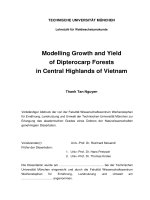
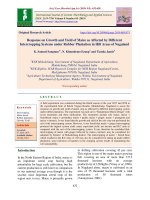
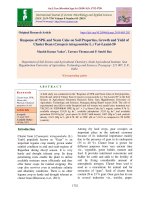
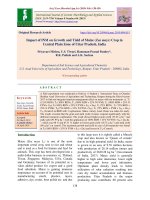
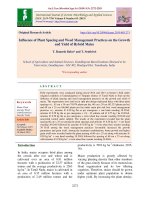
![Growth and yield of Ashwagandha [Withania somnifera (L.)] as influenced by different intercropping system in Kymore plateau of Madhya Pradesh](https://media.store123doc.com/images/document/2020_01/09/medium_vsb1578562778.jpg)
